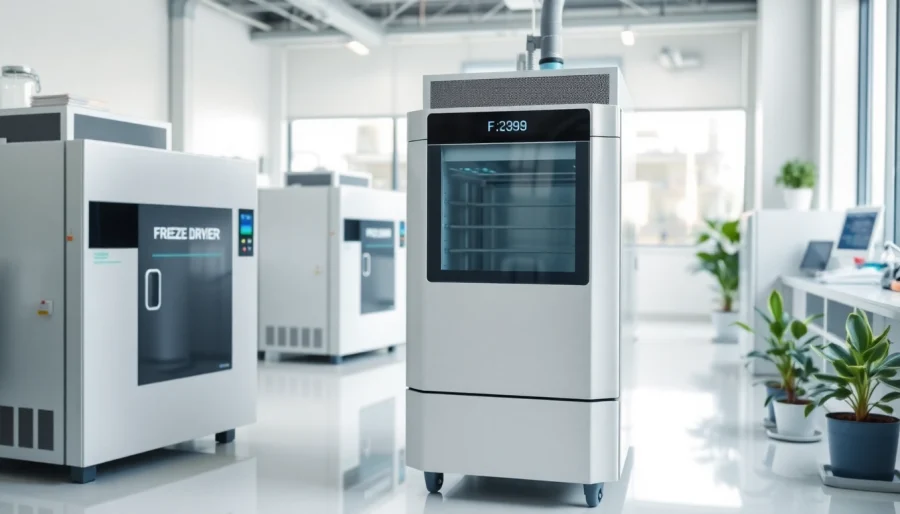Understanding Industrial Freeze Drying Equipment
Industrial freeze drying equipment plays a crucial role in many industries, from food preservation to pharmaceuticals. The process itself involves removing moisture from materials while preserving their structure and nutritional content. This article will delve into the intricacies of industrial freeze drying, its benefits, applications, equipment types, selection criteria, and operational best practices. For companies looking to enhance their preservation methods, investing in quality industrial freeze drying equipment can lead to significant long-term gains.
What is Industrial Freeze Drying?
Industrial freeze drying, or lyophilization, is a dehydration process used to preserve a wide variety of perishable materials. The process involves freezing the material, reducing the surrounding pressure, and removing the ice by sublimation. This advanced method is essential in preserving the physical form, flavor, and nutritional value of items, making them suitable for longevity without spoilage.
Benefits of Industrial Freeze Drying Equipment
Investing in industrial freeze drying equipment offers several benefits:
- Preservation of Nutritional Content: Freeze drying retains more nutrients compared to traditional drying methods, making products healthier.
- Extended Shelf Life: Products can last for years without refrigeration, greatly enhancing storage capabilities.
- Maintained Structural Integrity: Freeze drying preserves the original structure of the product, preventing textural changes.
- Reduced Weight and Volume: The removal of moisture reduces weight, making products easier to transport.
- Increased Versatility: This method is applicable across various industries, such as food, pharmaceuticals, and biotechnology.
Common Applications of Industrial Freeze Drying
Industrial freeze drying is employed in numerous sectors:
- Food and Beverage: Fruits, vegetables, and prepared meals benefit significantly from freeze drying, retaining taste and nutrients.
- Pharmaceuticals: Freeze-dried drugs and vaccines maintain potency and effectiveness longer than their liquid counterparts.
- Biotechnology: Cell cultures and biological samples are freeze-dried for easier transportation and storage.
- Pet Food: High-quality ingredients in pet food are preserved while ensuring flavor and nutritional value.
Types of Industrial Freeze Drying Equipment
Batch Freeze Dryers
Batch freeze dryers are popular for small to medium-scale production. They operate by processing a fixed amount of product at a time, making them ideal for specialized runs. These systems offer flexibility and are suitable for products with varying moisture contents.
Continuous Freeze Dryers
Continuous freeze dryers, on the other hand, streamline the production process by allowing an uninterrupted flow of material through the drying system. This type is suitable for large-scale manufacturing and is often integrated into manufacturing lines, enhancing efficiency and output.
Mobile Freeze Dryers
Mobile freeze drying units are compact, portable solutions that dissolve quickly for on-site operations. They are useful in scenarios where location flexibility is essential, such as remote food processing or pharmaceutical applications.
How to Select Industrial Freeze Drying Equipment
Key Factors to Consider
When selecting the right industrial freeze drying equipment, several factors should be considered:
- Product Type: Different materials require distinct drying processes, so understanding the product specifics is crucial.
- Scale of Production: Determine whether batch or continuous drying methods best fit your production goals.
- Energy Efficiency: Energy consumption impacts operational costs; seek equipment with high energy efficiency ratings.
- Space Requirements: Equipment size should conform to your facility’s spatial constraints.
Cost vs. Features Analysis
Choosing between cost and features is essential. While it may be tempting to select lower-cost options, the long-term benefits of advanced features often justify higher upfront costs. Features such as automated controls, precision temperature management, and vacuum systems can greatly increase efficiency and product quality.
Maintenance Requirements
Regular maintenance is critical for optimal performance. Consider the maintenance demands of the equipment and whether you have the necessary expertise or resources to manage it effectively. Look for manufacturers that offer comprehensive service agreements and support.
Operating and Using Industrial Freeze Drying Equipment
Setting Up Your Freeze Dryer
The setup of your freeze dryer is pivotal. Ensure that the equipment has adequate power supply, environmental conditions, and space. Verify that the vacuum system is functioning properly before initiating operations. Proper installation directly impacts performance, downtime, and product quality.
Best Practices for Operation
Implementing best practices during operation can lead to higher efficiency and improved results:
- Regularly calibrate temperature and pressure devices to maintain accuracy.
- Use only compatible materials in your freeze dryer to avoid contamination.
- Monitor moisture levels in your products to ensure optimal drying times.
Troubleshooting Common Issues
Even with the best equipment, problems may arise. Some common issues include:
- Poor Drying Efficiency: This might indicate issues with the vacuum seal or insufficient temperature control.
- Product Deformation: Temperature fluctuations could be a factor; ensure a consistent temperature is maintained throughout the process.
- Equipment Malfunction: Regular checks on mechanical parts and vacuum systems can prevent incidents and reduce downtime.
Performance Metrics for Industrial Freeze Drying Equipment
Measuring Efficiency and Output
To determine the efficiency of your industrial freeze drying process, consider monitoring specific metrics:
- Throughput: Measure the amount of product processed over a given period to assess efficiency.
- Energy Consumption: Analyze kilowatt usage per batch to identify energy-saving opportunities.
- Product Quality: Evaluate the moisture content and physical attributes of the freeze-dried products to ensure consistency and quality.
Quality Control Standards
Establish quality control standards to verify product integrity. Parameters such as moisture levels, texture, and taste should be tested regularly. Robust quality checks will help maintain compliance with industry standards and customer expectations.
Future Trends in Freeze Drying Technology
The future of freeze drying technology points toward even greater efficiency and sustainability. Advances in automation, machine learning, and energy efficiency are expected to transform the industry further. Key trends may include:
- Smart Freeze Dryers: Integration of monitoring systems to predict optimal drying cycles will enhance productivity.
- Sustainable Practices: Innovations focused on reducing energy usage and waste during production.
- Customizable Solutions: Equipment tailored to specific industry standards and applications.
